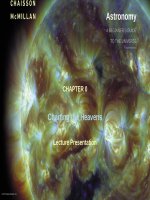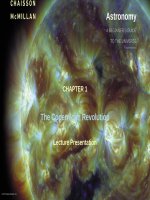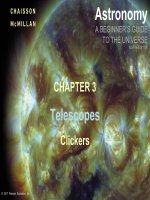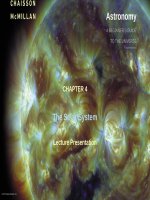- Trang chủ >>
- Khoa Học Tự Nhiên >>
- Vật lý
A users guide to the universe
Bạn đang xem bản rút gọn của tài liệu. Xem và tải ngay bản đầy đủ của tài liệu tại đây (2.85 MB, 307 trang )
A Us e r’s G u i d e
to the
Un i ve r s e
Surviving the Perils of Black Holes,
Time Paradoxes, and Quantum Uncertainty
D ave G o l d b e r g
and
Jeff Blomquist
IS SCHRÖDINGER’S CAT DEAD OR ALIVE? • IS THERE AN EXACT DUPLICATE OF YOU SOMEWHERE ELSE IN TIME AND SPACE? • CAN I BUILD A
GO BACK IN TIME AND BUY STOCK IN MICROSOFT? • IS THERE SOME WAY I CAN BLAME QUANTUM MECHANICS FOR ALL THE STUFF I LOSE?
• WHAT HAPPENS IF YOU FALL INTO A BLACK HOLE? • CAN WE BUILD A SHRINK RAY AND MAKE MINIATURE ATOMS? •
TRANSPORTER, LIKE ON STAR TREK ? • HOW FAST DOES A LIGHT BEAM GO IF YOU’RE RUNNING BESIDE IT? • CAN YOU
A U s e r’s G u i d e
to the
U n i ve rs e
Surviving the Perils of Black Holes, Time
Paradoxes, and Quantum Uncertainty
D ave G o l d b e rg a n d Je f f B l o m q u i s t
John Wiley & Sons, Inc.
This book is printed on acid-free paper.
Copyright © 2010 by Dave Goldberg and Jeff Blomquist. All rights reserved
Published by John Wiley & Sons, Inc., Hoboken, New Jersey
Published simultaneously in Canada
Photo credits: page 48, © Akira Tonomura; page 187, Andrew Fruchter (STScI) et al.,
WFPC2, HST, NASA; page 204, NASA/WMAP Science Team; page 231, J. R. Gott &
L.-X. Li
No part of this publication may be reproduced, stored in a retrieval system, or transmitted
in any form or by any means, electronic, mechanical, photocopying, recording, scanning,
or otherwise, except as permitted under Section 107 or 108 of the 1976 United States
Copyright Act, without either the prior written permission of the Publisher, or authorization
through payment of the appropriate per-copy fee to the Copyright Clearance Center, 222
Rosewood Drive, Danvers, MA 01923, (978) 750-8400, fax (978) 646-8600, or on the web
at www.copyright.com. Requests to the Publisher for permission should be addressed to the
Permissions Department, John Wiley & Sons, Inc., 111 River Street, Hoboken, NJ 07030,
(201) 748-6011, fax (201) 748-6008, or online at />Limit of Liability/Disclaimer of Warranty: While the publisher and the author have
used their best efforts in preparing this book, they make no representations or warranties
with respect to the accuracy or completeness of the contents of this book and specifically
disclaim any implied warranties of merchantability or fitness for a particular purpose.
No warranty may be created or extended by sales representatives or written sales materials. The advice and strategies contained herein may not be suitable for your situation.
You should consult with a professional where appropriate. Neither the publisher nor the
author shall be liable for any loss of profit or any other commercial damages, including
but not limited to special, incidental, consequential, or other damages.
For general information about our other products and services, please contact our
Customer Care Department within the United States at (800) 762-2974, outside the
United States at (317) 572-3993 or fax (317) 572-4002.
Wiley also publishes its books in a variety of electronic formats. Some content that
appears in print may not be available in electronic books. For more information about
Wiley products, visit our web site at www.wiley.com.
Library of Congress Cataloging-in-Publication Data:
Goldberg, Dave, date.
A user’s guide to the universe: surviving the perils of black holes, time paradoxes, and
quantum uncertainty / Dave Goldberg and Jeff Blomquist.
p. cm.
Includes index.
ISBN 978-0-470-49651-0 (cloth)
1. Physics—Popular works. I. Blomquist, Jeff II. Title.
QC24.5.G65 2010
530—dc22
2009028773
Printed in the United States of America
10
9
8
7
6
5
4
3
2
1
Contents
Acknowledgments vii
Introduction 1
“So, what do you do?”
1 Special Relativity 7
“What happens if I’m traveling at the speed of light,
and I try to look at myself in a mirror?”
Why can’t you tell how fast a ship is moving through fog? 11 • How fast
does a light beam go if you’re running beside it? 16 • If you head off in a
spaceship traveling at nearly the speed of light, what horrors await you when
you return? 20 • Can you reach the speed of light (and look at yourself in a
mirror)? 23 • Isn’t relativity supposed to be about turning atoms into limitless power? 26
2 Quantum Weirdness 33
“Is Schrödinger’s Cat Dead or Alive?”
Is light made of tiny particles, or a big wave? 38 • Can you change reality
just by looking at it? 43 • If you look at them closely enough, what are
iii
iv
C on t e n t s
electrons, really? 47 • Is there some way I can blame quantum mechanics
for all those times I lose things? 50 • Can I build a transporter, like on Star
Trek? 56 • If a tree falls in the forest and no one hears it, does it make a
sound? 59
3 Randomness 67
“Does God play dice with the universe?”
If the physical world is so unpredictable, why doesn’t it always seem that
way? 70 • How does carbon dating work? 76 • Does God play dice with
the universe? 80
4 The Standard Model 89
“Why didn’t the Large Hadron Collider destroy Earth?”
What do we need a multibillion-dollar accelerator for, anyway? 93 • How
do we discover subatomic particles? 99 • Why are there so many different rules for different particles? 103 • Where do the forces really come
from? 108 • Why can’t I lose weight (or mass)—all of it? 114 • How could
little ol’ LHC possibly destroy the great big world? 118 • If we discover the
Higgs, can physicists just call it a day? 122
5 Time Travel 131
“Can I build a time machine?”
Can I build a perpetual motion machine? 133 • Are black holes real, or
are they just made up by bored physicists? 137 • What happens if you fall
into a black hole? 142 • Can you go back in time and buy stock in
Microsoft? 145 • Who does time travel right? 151 • How can I build
a practical time machine? 154 • What are my prospects for changing the
past? 161
6 The Expanding Universe 165
“If the universe is expanding, what’s it expanding into?”
Where is the center of the universe? 170 • What’s at the edge of the
universe? 173 • What is empty space made of? 176 • How empty
C on t e n t s
is space? 181 • Where’s all of the stuff? 185 • Why is the universe
accelerating? 188 • What is the shape of the universe? 192 • What’s the
universe expanding into? 195
7 The Big Bang 199
“What happened before the Big Bang?”
Why can’t we see all the way back to the Big Bang? 205 • Shouldn’t the
universe be (half) filled with antimatter? 208 • Where do atoms come
from? 211 • How did particles gain all that weight? 216 • Is there an
exact duplicate of you somewhere else in time and space? 218 • Why is there
matter? 225 • What happened at the very beginning of time? 227 • What
was before the beginning? 228
8 Extraterrestrials 235
“Is there life on other planets?”
Where is everybody? 237 • How many habitable planets are
there? 241 • How long do intelligent civilizations last? 245 • What
are the odds against our own existence? 248
9 The Future 253
“What don’t we know?”
What is Dark Matter? 256 • How long do protons last? 264 • How massive or nuetinos? 267 • What won’t we know anytime soon? 274
Further Reading 281
Technical Reading 283
Index 291
v
Acknowledgments
This book has been a labor of love. We’ve tried to translate our love
of teaching and our love of physics into something that could be
understood and enjoyed by people at every level. We are so grateful
for the feedback from our friends, family, and colleagues. First and
foremost, Dave wants to thank his wife, Emily Joy, who was so supportive throughout, and who gave her honest opinions at every turn.
Jeff wishes to thank his family (especially his brother), who remained
politely neutral during the majority of his winded tirades and pointless
doodling; he is also grateful to Frank McCulley, Harry Augensen, and
Dave Goldberg, the three physicists who inspired him to give physics a fair shake. We are also indebted to feedback from Erica Caden,
Amy Fenton, Floyd Glenn, Rich Gott, Dick Haracz, Doug Jones, Josh
Kamensky, Janet Kim, Amy Lackpour, Patty Lazos, Sue Machler (aka
Dave’s mom), Jelena Maricic, Liz Patton, Gordon Richards, David
Spergel, Dan Tahaney, Brian Theurer, Michel Vallieres, Enrico Vesperini,
Alf Whitehead, Alyssa Wilson, and Steve Yenchik. We also would like
to acknowledge Geoff Marcy and Evelyn Thomson, with whom we had
several enlightening discussions. We appreciate Rich Gott and Akira
Tonomura allowing us to reproduce their figures. Thanks also to our
very hardworking agent, Andrew Stuart, and our excellent editors, Eric
Nelson and Constance Santisteban
vii
Introduction
“So, what do you do?”
T
he life of a physicist can be a lonely one.
Imagine this: You sit down in an airplane, and the
person next to you asks you what you do for a living. You
reply that you’re a physicist. From here, the conversation
can go one of two ways. Nine times out of ten, the first
thing out of his or her mouth is something along these lines: “Physics?
I hated that class!”*
You’ll then spend the rest of the trip (or party, or elevator ride, or
date) apologizing for the emotional trauma that physics has apparently
inflicted on your erstwhile friend. These random encounters often reveal
an almost joyful contempt, reserved specifically for the fields of physical
science and mathematics. “Oh, I’m terrible at algebra!” for example, is
said in an almost boastful tone, in a way that “I barely even know how
to read!” never would. But why?
Physics has a somewhat unfair reputation for being hard, impractical,
and boring. Hard? Perhaps. Impractical? Definitely not. Indeed, when
people try to “sell” physics to the public, it is almost always in terms
*
On reading a draft of the manuscript, Mrs. Goldberg finally revealed to me that she was
barely able to suppress a comment to this effect on our first date.
2
I n t ro d u c t i on
of how it can be used to build bridges or launch rockets—that is, how
physics is ultimately the foundation for engineering or chemistry.
But boring? That’s where we really take issue. The problem, as we
see it, is that the practical side of physics is almost always put forward at the expense of the interesting side. Even folks with technical
focuses such as engineering and computer science typically don’t get
past mechanics and electromagnetism to the really fun stuff. And that’s
a shame, because quite frankly there has been very little cutting-edge
research done on pulleys in the past few years.
This hostility to physics seems to be ingrained, and makes it difficult to have discussions without jading an audience. In starting a scientific conversation with a “civilian,” we purveyors of physics often feel
like we’re trying to force people to eat their vegetables, and rationalize
it in the same way. We never begin physics discussions with “It’s fun!”
but almost always with “It’s necessary,” which naturally drains all of
the fun out of it.
In an era when new technologies are constantly emerging, scientific
literacy should be fundamental. On the other hand, it isn’t necessary that
you have four extra years of college sciences to understand them. You
don’t need to have a detailed knowledge of exactly how the physics works
to appreciate the revolutions in quantum computing or cosmology. It is
important, rather, to understand why these developments are significant,
and how they are poised to change technology and our lives.
And it’s not simply that people need to understand a particular theory. Physics is the archetypal inductive science, and by understanding
how science proceeds, people are better able to make informed decisions
about issues from global warming to “theories” of intelligent design.
The hope is that we are more prepared to refute people who disagree
with us by offering facts rather than simply insisting “No.”
The United States, in particular, has an immense problem with science and mathematics education, with high school students performing
well below average compared to those in other developed countries. But
we cannot limit ourselves to only blaming teenagers, or their teachers,
or, for that matter, programs such as No Child Left Behind.
The problem is far-reaching, affecting all walks of life. It is most
evidently manifested in teenagers because we don’t sit down with people
3
4
A U s e r ’s G u i d e to t h e U n i ve rs e
in their fifties and ask science-y questions such as, “If you have ten
chickens and you eat five of them, how much does your cholesterol
go up?” Looking at a so-called practical story problem now makes the
whole premise of applied math seem absurd. At a very early stage,
many children throw up their arms and say, “When am I ever going to
need algebra?” and assume that the sole virtue in studying for the class
is getting a good grade.
In an excellent series of books, John Allen Paulos addresses the epidemic of “innumeracy” and through a series of lively essays on topics that
students normally don’t see, tries to give his readers the ability to think
critically about numerical concepts, and tries to show (successfully, in our
opinion) that mathematics is interesting above and beyond its practical
import in computing the tip on your bill or balancing your checkbook.
As your own experience may suggest, physics has the same break
between the practical and the groundbreaking. Although dry, mechanicsbased classes may drive people away from physics, they are sometimes
drawn back in by science fiction, or newspaper accounts of big discoveries, or the latest pictures from the Hubble Space Telescope.
These accounts, however, rarely feature the latest breakthroughs in
inclined plane technology.
Rather, when the public gets excited, it tends to be about the universe, or big experiments such as the Large Hadron Collider, or life on
other planets. We said before that nine times out of ten, our attempts
at discussing physics at an airport or cocktail party left us with
no phone number and a lonely cab ride home, but the rest of the time
something wonderful happens. Occasionally we will actually have conversations instead of confrontations. Sometimes we’re lucky enough to
be seated next to somebody who had a great physics teacher in high
school, or whose uncle works for NASA, or who is an engineer and
thinks what we’re doing is simply “quaint.”
In these cases, the conversation goes quite differently. It seems that
every so often we run into someone who has been holding a question
about how the universe works in reserve for some time but couldn’t
figure out the keywords to plug into Wikipedia. Maybe the latest NOVA
special only hinted at a topic, and they were eager to know more. Some
recent questions have included:
I n t ro d u c t i on
• I heard that the Large Hadron Collider is going to create mini
black holes that will destroy the universe. Is this true? (Providing
yet more evidence, as if any were needed, that physicists are
perceived as nothing more than mad scientists who would love
nothing more than to destroy Earth.)
• Is time travel possible?
• Are there other, parallel universes?
• If the universe is expanding, what’s it expanding into?
• What happens if I’m traveling at the speed of light and I try to
look at myself in the mirror?
These are the sorts of questions that got us excited about physics in
the first place. Indeed, the last question on the list above was one that
Albert Einstein himself posed, and was one of the main motivations for
his development of special relativity. In other words, when we talk to
people about what we do, we find that some people, however rare they
may be, are excited about exactly the same aspects of physics as we are.
The most obvious method is to make the subjects more approachable through available mathematics and science teaching materials. In
response to this, most textbook authors try to make physics exciting
by putting pictures of volcanoes, locomotives, and lightning bolts
on the covers.* The desired response, presumably, is that students
will look at the book and say, “Cool! Physics is really coming alive
for me!” Our own experience is that students aren’t fooled by these
ploys. If they are, they end up looking for the “How to Make Your
Own Lightning” chapter, and are even more disappointed when they
fail to locate it.
We’d like to note in passing that we don’t take that approach in
this book. You won’t see any cool graphics,† or anything else likely to
increase the publication costs of the book. Rather, our approach will be
quite simple: the physics itself is interesting. No, really! And if you need
further persuasion, we solemnly promise to deliver no fewer than five bad
*
On one humorously misguided cover, a bowling ball striking pins was intended to “bowl
students over” with the power of physics.
†
Though at least one of the authors submits that all the drawings are witty, informative, or both.
5
6
A U s e r ’s G u i d e to t h e U n i ve rs e
jokes per chapter (including groaners, puns, and facile cartoons). To give
you an idea of the sort of family-friendly humor you’re in for, consider the
following:
Q: What did the photon do at the ballpark?
A: The lightwave!
With that in mind, each chapter of this book will start with a cartoon
featuring an inexcusably terrible pun, and a question about how the
universe works. By way of answering the question, we’re going to
take you on a tour of the physics surrounding it, and by the end of
the chapter, it’s our hope that the mystery surrounding the question
will become clear, and that given the opportunity to reexamine it,
you will find the cartoon hilarious. We will do so in exactly the way
you’d expect from scientists—very circuitously.
That is not to say that you must be a physics guru to understand;
quite the contrary. Our aim is to find some middle ground between
those who appreciate the underlying majesty of the physics foundation and those who would rather gag themselves with a spoon than be
caught dead within a hundred yards of a protractor.
Without equations, many science writers usually resort to analogies, but the problem is that it isn’t always clear to the reader that
what’s being written is an analogy rather than a literal description of
a problem. Without using math, it’s clear that there will be some crucial element of the physics missing. What we’d like to convey is how
you would want to think about the problem, even if you don’t have the
equations to set it up. In other words, once you understand what’s really
going on, doing the math is just, well, math.
This description raises this question: What exactly do you eggheads
expect from me? In writing this book, we make no presumptions. Every
bit of evidence we present is constructed from the basics. It is not our
intention to scare you with mathematics or daunting equations. In fact,
why don’t we get all of the equations out of the way right now?
E = mc 2
That’s it. That didn’t hurt too badly, did it?
1
Special Relativity
“What happens if I’m traveling at the speed of
light, and I try to look at myself in a mirror?”
A
ll high school experiences have one thing in common:
there are always a handful of students—the cool kids—
who feel the insatiable need to mock everything and
everyone around them. This is why we like to think of
ourselves as the cool kids of physics, if such a thing could
be said to exist. We’ll give you an example.* We spent part of the
introduction making fun of textbook authors who need to use examples involving cataclysmic natural events, sports, or monster trucks to
“make physics come alive.” We aren’t backpedaling, but some of those
goofy examples have a tiny bit of merit.
That, and we know in our heart of hearts that we’ll never get this
physics party started unless we set off some fireworks. If you’ve ever
been to the local Chamber of Commerce Independence Day celebration and decided to get a little physics in, you’ll have noted that there’s
a time delay between the rockets’ red glare and the sounds of bombs
bursting in air. You see the explosion several seconds before you hear
the sound. You’ve probably experienced the same thing if you’ve ever
had back-of-the-theater tickets at a concert: the music and the musicians suffer a delay. Sound moves fast, but light moves faster.
*And,
8
perhaps, a wedgie.
S p e c i a l R e lat i v i t y
In 1638, Galileo of Pisa (one of the original cool kids of physics)
devised a scheme to figure out the speed of light. The experiment went
like this: Galileo parked himself on a hill with a lantern, while his assistant, armed with his own lantern, walked far away to a different, distant
hill. The two signaled each other. Each time Galileo saw his assistant’s
lantern open or close, he would toggle his own, and vice versa. By performing the experiment on more and more distant hills, Galileo hoped
to measure the speed of light. The precision wasn’t really there, but no
one can blame him for taking a crack at it, and he did come to a pretty
interesting conclusion.
If it isn’t infinite, the speed of light is pretty darn fast.
Over the next few centuries, physicists made ever more precise measurements, but we won’t bother you with the design specs for the intricate instrumentation. Suffice it to say that as time went on, scientists
grew more and more determined to shed light on light.
9
10
A U s e r ’s G u i d e to t h e U n i ve rs e
The modern value of the speed of light is 299,792,458 meters per
second. Rather than rattle off all of the digits, we’ll simply call it c for
the Latin celeritas, meaning “swift.” This measurement is not the kind
of number you get with a ruler and an egg timer. To measure c this precisely, you have to use an atomic clock powered by cesium-133 atoms.
The scientific community defines the second as exactly 9,192,631,770
times the frequency of light emitted by the “hyperfine transition” of
cesium-133. This may sound like it’s unnecessarily confusing, but it
actually simplifies things a great deal.* The second, like your hat size,
becomes something that we define in terms of something real; a bunch
of physicists could build cesium clocks, and since all cesium acts the
same, everyone tells the same time.
We’ve come up with a creative way of defining the second, but how
does that help us measure the speed of light? Speeds are ratios of distance
over time, such as miles per hour, and defining the second gives us some
leverage. The only thing left to do is determine the length of a meter.
This may seem pretty obvious since a meter is exactly one meter long.
Just get out a meter stick and you’re all set. But how long is that?
From 1889 until 1983, if you wanted to know how tall you were,
you’d have to go to the International Bureau of Weights and Measures
in Sèvres, France, go into their vault, and take out their platinum meter
stick to measure yourself. Not only was this cumbersome (and illegal,
if you didn’t ask nicely to use it first), it tends to be pretty inaccurate.
Most materials, including platinum, expand when heated. Under the
old system, a meter was slightly longer on hot days than cool ones.
So instead of using an actual meter stick, we have a clock capable of
measuring a second, and we define a meter as 1/299,792,458 the distance that light travels in 1 second. To make this blindingly obvious,
what we’ve done is say, “We know the speed of light exactly. But meters,
on the other hand, have a tiny uncertainty.” All this hard work means
that we can normalize the second and the meter, and everyone uses the
same measurement system.
*At
least it simplifies things for scientists who know what “hyperfine transitions” are. You
don’t need to know; it won’t be on the test.
S p e c i a l R e lat i v i t y
Keep in mind, though, that the crux of it all is that light doesn’t
move infinitely fast. Not impressed? Brace yourself for a philosophical
bombshell: because light moves at a finite speed, we are forever gazing
into the past. As you’re reading this book, a foot in front of you, you’re
seeing it as it was about a billionth of a second earlier. The light from
the Sun takes about eight minutes to reach Earth, so our star could well
have burned out five minutes ago and we’d have no way of knowing it.*
When we look at stars in our Galaxy, the light takes hundreds, or even
thousands of years to reach us, and so it is a very real possibility that
some of the stars we see in the sky are no longer around.
Why can’t you tell how fast a ship
is moving through fog?
No experiment has ever produced a particle traveling faster than the
speed of light.† The speed limit of the universe seems to be something
we can’t brush off even if we wanted to, and the constant speed of light
is just the first of two ingredients in what will turn out to be one of
the finest physics dishes ever cooked. For the second, we need to think
about what it even means to be moving at all.
Allow us to introduce you to Rusty, a physicist-hobo riding the rails,
ostracized by society for the unique standards of hygiene common to
his lot. Rusty has managed to “borrow” the platinum meter stick from
the International Bureau of Standards (which, while not perfect, is still
pretty good by hobo standards), and he has a bunch of cesium atoms to
build an atomic clock.
He passes his day by throwing his bindle‡ across the train. Each time
he throws it, he measures the distance it travels, and the time it takes
*At
least not for another 180 seconds or so.
For those of you especially well versed in sci-fi lore, you might have heard of a hypothetical
particle called the tachyon, which can only travel faster than the speed of light. No one has
ever detected one. As a real particle (rather than as a mathematical construct), the tachyon is
really most at home in science fiction rather than in this discussion.
‡In case you’ve forgotten, that’s the stick with a polka-dot sack at the end of it.
†
11
12
A U s e r ’s G u i d e to t h e U n i ve rs e
to cover that distance. Since speed is the ratio of distance traveled compared to the time it takes to cover that distance (miles per hour), Rusty
is able to calculate the speed of his bindle with high accuracy.
After a tiring day of bindle-tossing, Rusty nods off to sleep, and he
awakes in his own private freight car. Since freight cars don’t have any
windows, and the train is moving on smooth track, he finds himself
somewhat disoriented when he slides open the door and finds that he is
moving. You may have noticed that even in cars, you sometimes can’t
tell that you’re moving without looking out the window.
You also may not have noticed that if you’re standing on the equator, you’re moving at more than 1,000 mph around the center of Earth.
Faster still, Earth is moving at about 68,000 mph around the Sun. And
the Sun is moving at close to 500,000 mph around the center of our
Milky Way Galaxy, which, in turn, is traveling through space at well
over 1 million mph.
The point is that you (or Rusty) don’t notice the train (or Earth, or
the Sun, or the Galaxy) moving, regardless of how fast it’s moving, as long
as it does so smoothly and in a straight line.
Galileo used this argument in favor of Earth going around the Sun.
Most people at the time assumed that you’d be able to somehow feel
Earth’s motion as it flies around the Sun, so therefore we must be
standing still.
“Nonsense!” said Galileo. Not having a ready supply of either hobos
or trains, he compared the motion of Earth to a ship moving on a calm
sea. It’s impossible for a sailor to tell under those circumstances whether
he’s moving or standing still. This principle has come to be known as
“Galilean relativity” (not to be confused with Albert Einstein’s special
relativity, which we will encounter shortly).
According to Galileo (and Isaac Newton, and ultimately Einstein)
there is quite literally no experiment you can do on a smoothly moving train that will give a different result than if you were sitting still.
Think back to trips with your family in which you threw mustard packets at your little brother until your parents threatened to “turn this car
around this minute, young man!” Even though the car was moving at
60 mph or more, you threw the packets exactly as you would have if the
car were sitting still. Like it or not, all of that tormenting was nothing
more than a simple physics experiment. On the other hand, this is only
S p e c i a l R e lat i v i t y
true if the speed and direction of the car/train/planet/galaxy are exactly
(or really, really close to) constant. You definitely felt it if your parents
actually made good on their threat and slammed on the brakes.
So when he awakes from his blissful hobo slumber to return to his
bindle-tossing experiments, Rusty might be quite unaware that the train
has started steadily moving at about 15 mph. After arranging himself at
one end of the train car, he tosses his bindle and measures the speed at,
say, 5 mph. Patches, a fellow hobo-physicist, stands outside the moving
train but also decides to participate. Using special hobo X-ray goggles
to see through the train’s walls, he also measures the speed of the bindle
as Rusty throws it. Patches, from his vantage point outside the train, finds
the bindle to move at about 20 mph (the 15 mph that Rusty’s train is
moving plus the 5 mph of the bindle).
13
14
A U s e r ’s G u i d e to t h e U n i ve rs e
So who’s right? Is the bindle moving at 5 mph or 20 mph? Well,
both are correct. We’d say that it’s moving at 20 mph with respect to
Patches and 5 mph with respect to Rusty.
Now imagine that our train has a high-tech lab equipped with lasers
(which, being made of light, naturally travel at c). At one end of the
train sits the laser, manned by Rusty. At the other end of the train sits
an open can of baked beans. If Rusty turned on the laser for a short
pulse (to heat his baked beans, naturally) and measured the time for
the beans to start cooking, he could compute the speed of the laser, and
he’d find it to be c.
What about Patches? He will, presumably, measure the same amount
of time for the light pulse to reach the detector. However, according
to him, the light doesn’t have to travel as far to get there, so he should
measure the speed of the pulse to be faster than c. In fact, common sense
tells us that he should measure the pulse to be moving at c ϩ 15 mph.
S p e c i a l R e lat i v i t y
Earlier we said that Einstein assumed that the speed of light is constant
for all observers, but by our reasoning the beam doesn’t appear to be
constant. Not constant at all! Could the great Einstein be wrong?*
Fifteen pages into the book, and we’ve already broken the laws of physics. We couldn’t be any more embarrassed if we showed up to a party
wearing the same dress as the hostess. It looks like we just blew it. If
only there were some obsessive scientist we could look to, some concrete example to revalidate the concept of c as a constant.
We just so happen to have such a scientist. His name was Albert
Michelson, and he loved light in a way that today might be characterized as “driving” or “unhealthy.” His scientific career began in 1881,
after he left the navy to pursue science. He measured light independently for a while, doing gigs in Berlin, Potsdam, and Canada, until
he met Edward Morley. They worked together to produce ever more
elaborate devices for measuring the speed of light, eventually reaching
number 1 with “Bridge over Troubled Water,” which stayed at the top
of the charts for six straight weeks.
The devices they constructed worked on the following basic premise:
since Earth travels around the Sun once a year, relative to the sun their
lab should travel at different speeds and in different directions at different times of year. Michelson’s “interferometer” was designed to measure whether the speed of light was different when moving in different
directions. Your basic intuition should tell you that as Earth moves
toward or away from the Sun, the measured value of c should change.
Your intuition is wrong. In experiment after experiment, Michelson
and Morley showed that no matter what the direction of motion, the
speed of light was the same everywhere.
As of 1887, this was a pretty big conundrum, and it defied the senses
because this only seems to work for light. If you found yourself on a bike,
face-to-face with an angry cow, it would make all the difference in the world
whether you rode toward or away from the charging animal. Whether you
run toward or away from a light source, on the other hand, c is c.
*
Not in this case. But he did mess up at least twice, and we’ll talk about those instances in
chapters 3 and 6.
15









